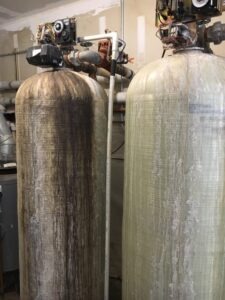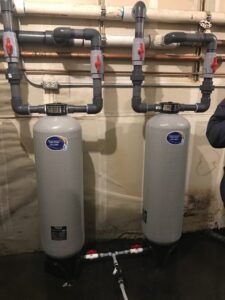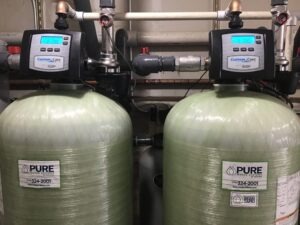Before and After: Manganese and Sand Removal from water for a Non-Transient Water System

We recently completed an installation for a non-transient water system in Fallon, NV. The well that feeds the system had high levels of sand and manganese that was intermittently over the EPA maximum contaminant level.
The original equipment was about 15 years old and not installed by our company. The old water filters had to be replaced for a few reasons:
- The original installation did not account for the sand in the water, so the sand had caused numerous service problems and had actually filled the freeboard of the filtration tanks so they couldn’t backwash. When we went to remove the tanks, we actually had to chop the tops of with a saws all and scoop out a couple feet of what looked like beach sand before we got to the filtration media.
- Due to the numerous service issues and the age of the equipment, it was not worth salvaging or continuing to repair.
- The new Custom Care C43 Air units utilized the newest technology and media to remove manganese more effectively and efficiently than the old tanks.

The original tanks looked like the first image to the right:
You can see the staining on the front from multiple leaks over the years and the missing covers on the control valves from all of the repairs when the sand chewed up another set of seals and spacers.
Step 1 for Pure Water Systems was to remove the existing tanks and installing our centrifugal sand separators. These tanks utilize the flow of water and gravity to settle out heavy sand and sediment. Then they flush the sand down the drain with an automated blow down.
Step 2 was to install the Custom Care C43 Air units with Greensand Plus media to remove the manganese. The room is not large, and there was not enough wall space for all of the equipment so the decision was made to put the manganese tanks in front of the sand separators. and angle the plumbing in such a way as to minimize the footprint of the system.

The final result looked like the last image on the right:
Because this system is a non-transient water system, the water system had to be approved by the Nevada Department of Environmental Protection (NDEP). Shaw Engineering in Reno, NV was instrumental in drafting plans and working with the state to get the system approved so the park could get the water system they needed.